Analyzing the Progress of Renewable Energy in the UK from 2009 to 2016
VerifiedAdded on 2020/04/21
|37
|13276
|91
AI Summary
This analysis examines the UK's renewable energy progression from 2009 to 2016. During this period, overall renewable energy capacity rose significantly, with an average annual growth rate of about 25% until 2015. The power sector, supported by initiatives like Renewable Obligation and Feed-in Tariffs, saw substantial development but faced uncertainties post-2017 due to changes in policy and market dynamics. In contrast, renewable heat grew at a steady pace thanks to the Renewable Heat Incentive, although biomass boilers and bio methane were predominant. Biofuels usage showed stagnation after initial growth, reflecting market challenges. Employment in the sector increased by 4.2%, yet company numbers slightly decreased, with notable declines in solar PV businesses due to policy shifts affecting job prospects.
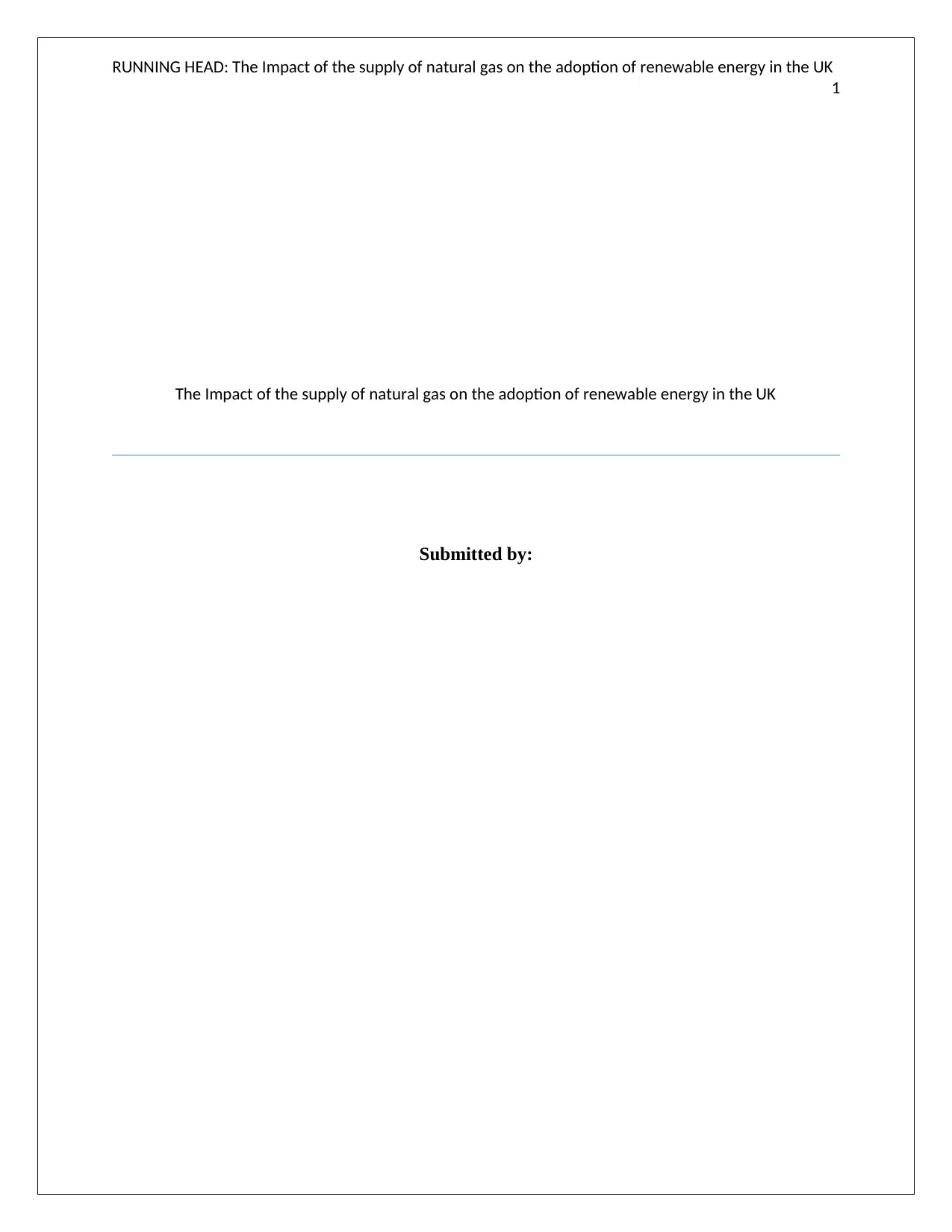
RUNNING HEAD: The Impact of the supply of natural gas on the adoption of renewable energy in the UK
1
The Impact of the supply of natural gas on the adoption of renewable energy in the UK
Submitted by:
1
The Impact of the supply of natural gas on the adoption of renewable energy in the UK
Submitted by:
Paraphrase This Document
Need a fresh take? Get an instant paraphrase of this document with our AI Paraphraser

Dissertation 2
Contents
Chapter 1: Introduction....................................................................................................................4
1.1 Introduction............................................................................................................................4
1.2 Research Background............................................................................................................4
1.3 Rationale of the Research......................................................................................................5
1.4 Problem Statement.................................................................................................................5
1.5 Research Aims and objectives...............................................................................................6
Research aims:..........................................................................................................................6
Research Objectives:................................................................................................................6
Chapter 2 Literature Review........................................................................................................7
Introduction..............................................................................................................................7
Natural gas supply landscape.......................................................................................................8
Overview of UK energy mix........................................................................................................8
Onshore wind generation...........................................................................................................10
Renewable energy provision in the UK.....................................................................................11
Challenges and Future Outlook..................................................................................................11
Chapter 3: Research Methodology................................................................................................12
3.1 Introduction..........................................................................................................................12
3.2 Research Philosophy............................................................................................................13
3.3 Research Strategy.................................................................................................................14
3.4 Research Methods................................................................................................................14
3.5 Reliability and validity.....................................................................................................14
3.6 Research Ethics....................................................................................................................15
3.7 Research Limitation.............................................................................................................15
Contents
Chapter 1: Introduction....................................................................................................................4
1.1 Introduction............................................................................................................................4
1.2 Research Background............................................................................................................4
1.3 Rationale of the Research......................................................................................................5
1.4 Problem Statement.................................................................................................................5
1.5 Research Aims and objectives...............................................................................................6
Research aims:..........................................................................................................................6
Research Objectives:................................................................................................................6
Chapter 2 Literature Review........................................................................................................7
Introduction..............................................................................................................................7
Natural gas supply landscape.......................................................................................................8
Overview of UK energy mix........................................................................................................8
Onshore wind generation...........................................................................................................10
Renewable energy provision in the UK.....................................................................................11
Challenges and Future Outlook..................................................................................................11
Chapter 3: Research Methodology................................................................................................12
3.1 Introduction..........................................................................................................................12
3.2 Research Philosophy............................................................................................................13
3.3 Research Strategy.................................................................................................................14
3.4 Research Methods................................................................................................................14
3.5 Reliability and validity.....................................................................................................14
3.6 Research Ethics....................................................................................................................15
3.7 Research Limitation.............................................................................................................15
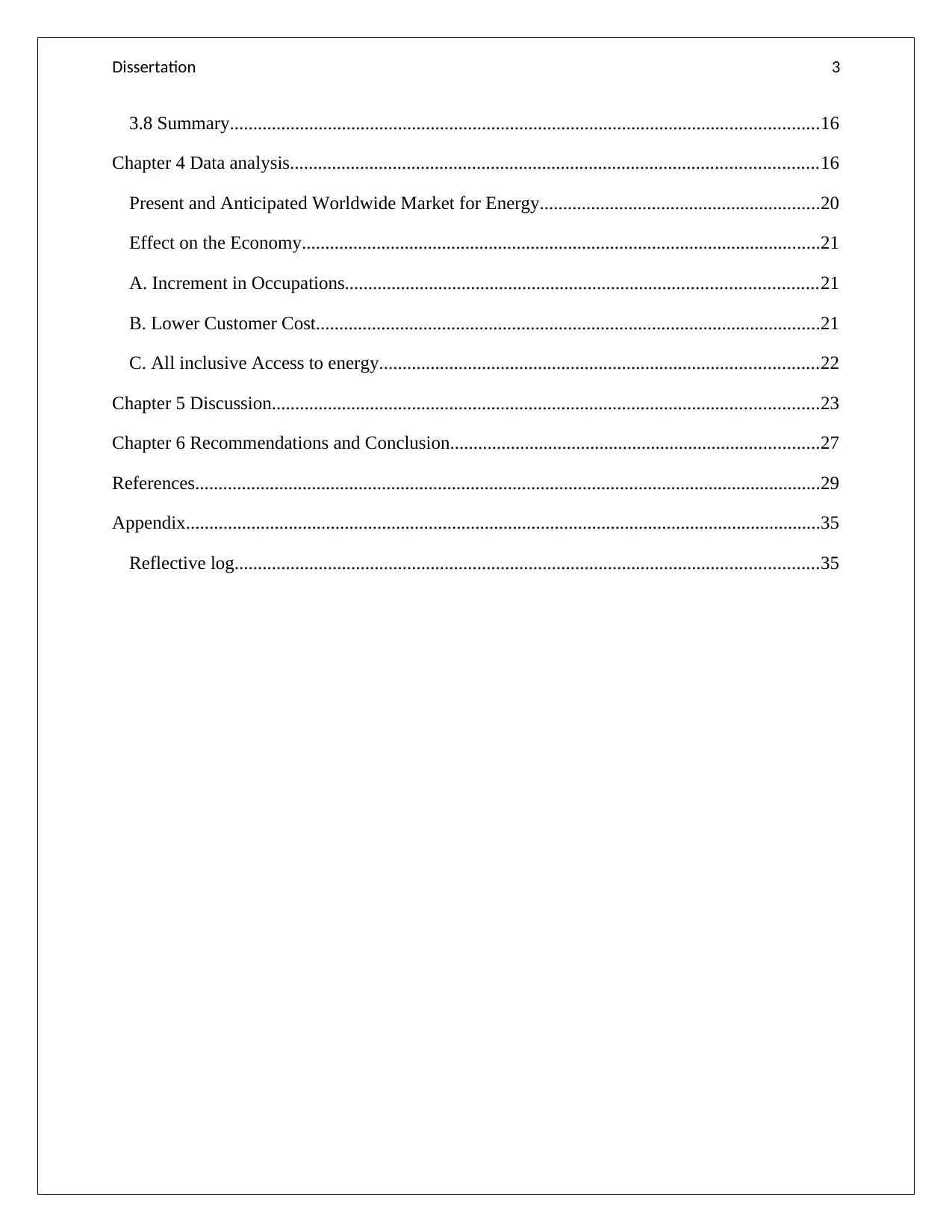
Dissertation 3
3.8 Summary..............................................................................................................................16
Chapter 4 Data analysis.................................................................................................................16
Present and Anticipated Worldwide Market for Energy............................................................20
Effect on the Economy...............................................................................................................21
A. Increment in Occupations.....................................................................................................21
B. Lower Customer Cost............................................................................................................21
C. All inclusive Access to energy..............................................................................................22
Chapter 5 Discussion.....................................................................................................................23
Chapter 6 Recommendations and Conclusion...............................................................................27
References......................................................................................................................................29
Appendix........................................................................................................................................35
Reflective log.............................................................................................................................35
3.8 Summary..............................................................................................................................16
Chapter 4 Data analysis.................................................................................................................16
Present and Anticipated Worldwide Market for Energy............................................................20
Effect on the Economy...............................................................................................................21
A. Increment in Occupations.....................................................................................................21
B. Lower Customer Cost............................................................................................................21
C. All inclusive Access to energy..............................................................................................22
Chapter 5 Discussion.....................................................................................................................23
Chapter 6 Recommendations and Conclusion...............................................................................27
References......................................................................................................................................29
Appendix........................................................................................................................................35
Reflective log.............................................................................................................................35
⊘ This is a preview!⊘
Do you want full access?
Subscribe today to unlock all pages.

Trusted by 1+ million students worldwide
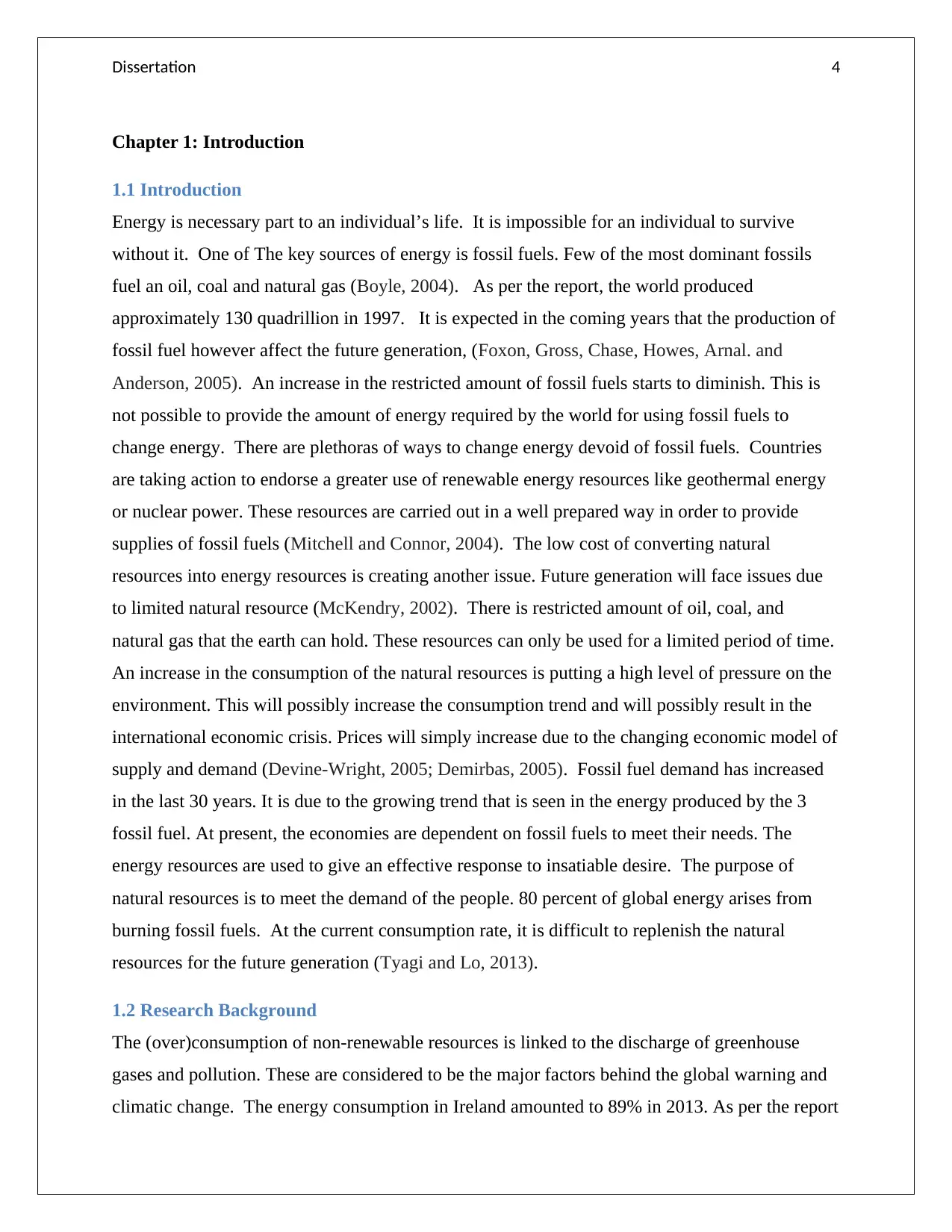
Dissertation 4
Chapter 1: Introduction
1.1 Introduction
Energy is necessary part to an individual’s life. It is impossible for an individual to survive
without it. One of The key sources of energy is fossil fuels. Few of the most dominant fossils
fuel an oil, coal and natural gas (Boyle, 2004). As per the report, the world produced
approximately 130 quadrillion in 1997. It is expected in the coming years that the production of
fossil fuel however affect the future generation, (Foxon, Gross, Chase, Howes, Arnal. and
Anderson, 2005). An increase in the restricted amount of fossil fuels starts to diminish. This is
not possible to provide the amount of energy required by the world for using fossil fuels to
change energy. There are plethoras of ways to change energy devoid of fossil fuels. Countries
are taking action to endorse a greater use of renewable energy resources like geothermal energy
or nuclear power. These resources are carried out in a well prepared way in order to provide
supplies of fossil fuels (Mitchell and Connor, 2004). The low cost of converting natural
resources into energy resources is creating another issue. Future generation will face issues due
to limited natural resource (McKendry, 2002). There is restricted amount of oil, coal, and
natural gas that the earth can hold. These resources can only be used for a limited period of time.
An increase in the consumption of the natural resources is putting a high level of pressure on the
environment. This will possibly increase the consumption trend and will possibly result in the
international economic crisis. Prices will simply increase due to the changing economic model of
supply and demand (Devine-Wright, 2005; Demirbas, 2005). Fossil fuel demand has increased
in the last 30 years. It is due to the growing trend that is seen in the energy produced by the 3
fossil fuel. At present, the economies are dependent on fossil fuels to meet their needs. The
energy resources are used to give an effective response to insatiable desire. The purpose of
natural resources is to meet the demand of the people. 80 percent of global energy arises from
burning fossil fuels. At the current consumption rate, it is difficult to replenish the natural
resources for the future generation (Tyagi and Lo, 2013).
1.2 Research Background
The (over)consumption of non-renewable resources is linked to the discharge of greenhouse
gases and pollution. These are considered to be the major factors behind the global warning and
climatic change. The energy consumption in Ireland amounted to 89% in 2013. As per the report
Chapter 1: Introduction
1.1 Introduction
Energy is necessary part to an individual’s life. It is impossible for an individual to survive
without it. One of The key sources of energy is fossil fuels. Few of the most dominant fossils
fuel an oil, coal and natural gas (Boyle, 2004). As per the report, the world produced
approximately 130 quadrillion in 1997. It is expected in the coming years that the production of
fossil fuel however affect the future generation, (Foxon, Gross, Chase, Howes, Arnal. and
Anderson, 2005). An increase in the restricted amount of fossil fuels starts to diminish. This is
not possible to provide the amount of energy required by the world for using fossil fuels to
change energy. There are plethoras of ways to change energy devoid of fossil fuels. Countries
are taking action to endorse a greater use of renewable energy resources like geothermal energy
or nuclear power. These resources are carried out in a well prepared way in order to provide
supplies of fossil fuels (Mitchell and Connor, 2004). The low cost of converting natural
resources into energy resources is creating another issue. Future generation will face issues due
to limited natural resource (McKendry, 2002). There is restricted amount of oil, coal, and
natural gas that the earth can hold. These resources can only be used for a limited period of time.
An increase in the consumption of the natural resources is putting a high level of pressure on the
environment. This will possibly increase the consumption trend and will possibly result in the
international economic crisis. Prices will simply increase due to the changing economic model of
supply and demand (Devine-Wright, 2005; Demirbas, 2005). Fossil fuel demand has increased
in the last 30 years. It is due to the growing trend that is seen in the energy produced by the 3
fossil fuel. At present, the economies are dependent on fossil fuels to meet their needs. The
energy resources are used to give an effective response to insatiable desire. The purpose of
natural resources is to meet the demand of the people. 80 percent of global energy arises from
burning fossil fuels. At the current consumption rate, it is difficult to replenish the natural
resources for the future generation (Tyagi and Lo, 2013).
1.2 Research Background
The (over)consumption of non-renewable resources is linked to the discharge of greenhouse
gases and pollution. These are considered to be the major factors behind the global warning and
climatic change. The energy consumption in Ireland amounted to 89% in 2013. As per the report
Paraphrase This Document
Need a fresh take? Get an instant paraphrase of this document with our AI Paraphraser

Dissertation 5
presented by Department of Energy and Climatic Change, UK will be able to catch up with the
target of 15 percent by 2020 through renewable resources. As per the Research, ‘bottom-up’
analysis, tested with industry, that there is noteworthy upside potential as well as downside threat
to consumption. Moreover, there are around 8 technologies competent of delivering 90% of the
renewable energy by 2020(Perry, Klemeš and Bulatov, 2008).
1.3 Rationale of the1 Research
The underlying principle is related to the research in the given section of the introduction chapter
aims to provide with reasonable research study. The rationale provides with a set of reasons that
offer researchers to find out information related to a particular topic. In the context of the
research study, the research aims to understand the Impact of supply of natural gas on the
adoption of renewable energy in the UK. The renewable energy has become a well-established
necessity important for the energy development and management. The study critically evaluates
the factors that affect the supply of renewable energy resources and consumer behavior in large.
The accessible pipeline of large-scale projects is well-built, and permitting significant dropout
rates, to put on an addition of 29 GW of operational capacity by 2020. It is helping in introducing
the world’s first incentive for renewable heat, delivering 124,000 renewable heat installations by
2020. In addition the road transport biofuels make up over 3 percent volume of all road transport
fuel. Subject to this, government will make appropriate arrangements regarding the changes that
are taking place in the procurement of energy resources (Upreti and van der Horst, 2004; Dincer,
2000).
1.4 Problem Statement
The problem statement provides with a brief description of the required topic to be concentrated
on by acquire noteworthy information. In the context of the research study, it focuses on the
costs and the supply chain. There will be serious challenges in technicalities and the cost of
capital with an increase in the risk. The cross-cutting barriers to operation for renewable energy
technologies are applied to specific technologies, in order to address the issue in order to achieve
the aim (Scarpa and Willis, 2010). As per the report in The Guardian, Renewable Energy
amounted to 30 percent of the total UK power consumption in between April to June. The
changing pattern in the energy consumption is considered to be revolutionary. Consumers are
now realizing the importance of renewable resources necessary for managing the needs
presented by Department of Energy and Climatic Change, UK will be able to catch up with the
target of 15 percent by 2020 through renewable resources. As per the Research, ‘bottom-up’
analysis, tested with industry, that there is noteworthy upside potential as well as downside threat
to consumption. Moreover, there are around 8 technologies competent of delivering 90% of the
renewable energy by 2020(Perry, Klemeš and Bulatov, 2008).
1.3 Rationale of the1 Research
The underlying principle is related to the research in the given section of the introduction chapter
aims to provide with reasonable research study. The rationale provides with a set of reasons that
offer researchers to find out information related to a particular topic. In the context of the
research study, the research aims to understand the Impact of supply of natural gas on the
adoption of renewable energy in the UK. The renewable energy has become a well-established
necessity important for the energy development and management. The study critically evaluates
the factors that affect the supply of renewable energy resources and consumer behavior in large.
The accessible pipeline of large-scale projects is well-built, and permitting significant dropout
rates, to put on an addition of 29 GW of operational capacity by 2020. It is helping in introducing
the world’s first incentive for renewable heat, delivering 124,000 renewable heat installations by
2020. In addition the road transport biofuels make up over 3 percent volume of all road transport
fuel. Subject to this, government will make appropriate arrangements regarding the changes that
are taking place in the procurement of energy resources (Upreti and van der Horst, 2004; Dincer,
2000).
1.4 Problem Statement
The problem statement provides with a brief description of the required topic to be concentrated
on by acquire noteworthy information. In the context of the research study, it focuses on the
costs and the supply chain. There will be serious challenges in technicalities and the cost of
capital with an increase in the risk. The cross-cutting barriers to operation for renewable energy
technologies are applied to specific technologies, in order to address the issue in order to achieve
the aim (Scarpa and Willis, 2010). As per the report in The Guardian, Renewable Energy
amounted to 30 percent of the total UK power consumption in between April to June. The
changing pattern in the energy consumption is considered to be revolutionary. Consumers are
now realizing the importance of renewable resources necessary for managing the needs

Dissertation 6
pertaining of natural resources. In order to address the above mentioned issue, the problem
statement can be stated as, Whether the adoption of renewable energy in the UK Focus on
aspects such production, costing price levels, consumers willingness to switch or not?
1.5 Research Aims and objectives
The research paper and aim are important part of the overall study. It acts as a guiding path for
the researcher. The paper primarily focus on the Impact of supply of natural gas on the adoption
of renewable energy in the UK and Focus on aspects such as production, costing, price levels,
consumers willingness to switch. The purpose is to focus on the changes in the environment and
consider entity actions depend upon an individual behavior.
Research aims:
The primary aim of the study is to find out the utilization of renewable energy resources and
consumption pattern in UK. These results are important and steady in finding the changes in the
study related to the management of energy and resource pattern in order to manage the resources
in the most appropriate way. This will however help in managing the resources in the most
appropriate way by indulging into an effective market pattern in UK (Wang, et al 2009).
Research Objectives:
In order to achieve the primary objective of the research study, the researcher requires addressing
the following objectives to gain an effective study.
To examine the theory that examines the supply of natural gas in The UK. Moreover, it
focuses to be persuaded in a positive direction in order to take requisite actions (Grubb,
Butler and Twomey, 2006).
To study the pattern seen in the economy in the recent years. This is not only necessary to
manage the ongoing economy pattern in order to realize the changes that are taking place
in the supply of renewable source of energy.
To analyse the critical difference while undertaking the behavior of the critical mass. It is
important for managing the resources in the most effective way by allocating the
resources in the most appropriate way (Twidell and Weir, 2015).
pertaining of natural resources. In order to address the above mentioned issue, the problem
statement can be stated as, Whether the adoption of renewable energy in the UK Focus on
aspects such production, costing price levels, consumers willingness to switch or not?
1.5 Research Aims and objectives
The research paper and aim are important part of the overall study. It acts as a guiding path for
the researcher. The paper primarily focus on the Impact of supply of natural gas on the adoption
of renewable energy in the UK and Focus on aspects such as production, costing, price levels,
consumers willingness to switch. The purpose is to focus on the changes in the environment and
consider entity actions depend upon an individual behavior.
Research aims:
The primary aim of the study is to find out the utilization of renewable energy resources and
consumption pattern in UK. These results are important and steady in finding the changes in the
study related to the management of energy and resource pattern in order to manage the resources
in the most appropriate way. This will however help in managing the resources in the most
appropriate way by indulging into an effective market pattern in UK (Wang, et al 2009).
Research Objectives:
In order to achieve the primary objective of the research study, the researcher requires addressing
the following objectives to gain an effective study.
To examine the theory that examines the supply of natural gas in The UK. Moreover, it
focuses to be persuaded in a positive direction in order to take requisite actions (Grubb,
Butler and Twomey, 2006).
To study the pattern seen in the economy in the recent years. This is not only necessary to
manage the ongoing economy pattern in order to realize the changes that are taking place
in the supply of renewable source of energy.
To analyse the critical difference while undertaking the behavior of the critical mass. It is
important for managing the resources in the most effective way by allocating the
resources in the most appropriate way (Twidell and Weir, 2015).
⊘ This is a preview!⊘
Do you want full access?
Subscribe today to unlock all pages.

Trusted by 1+ million students worldwide
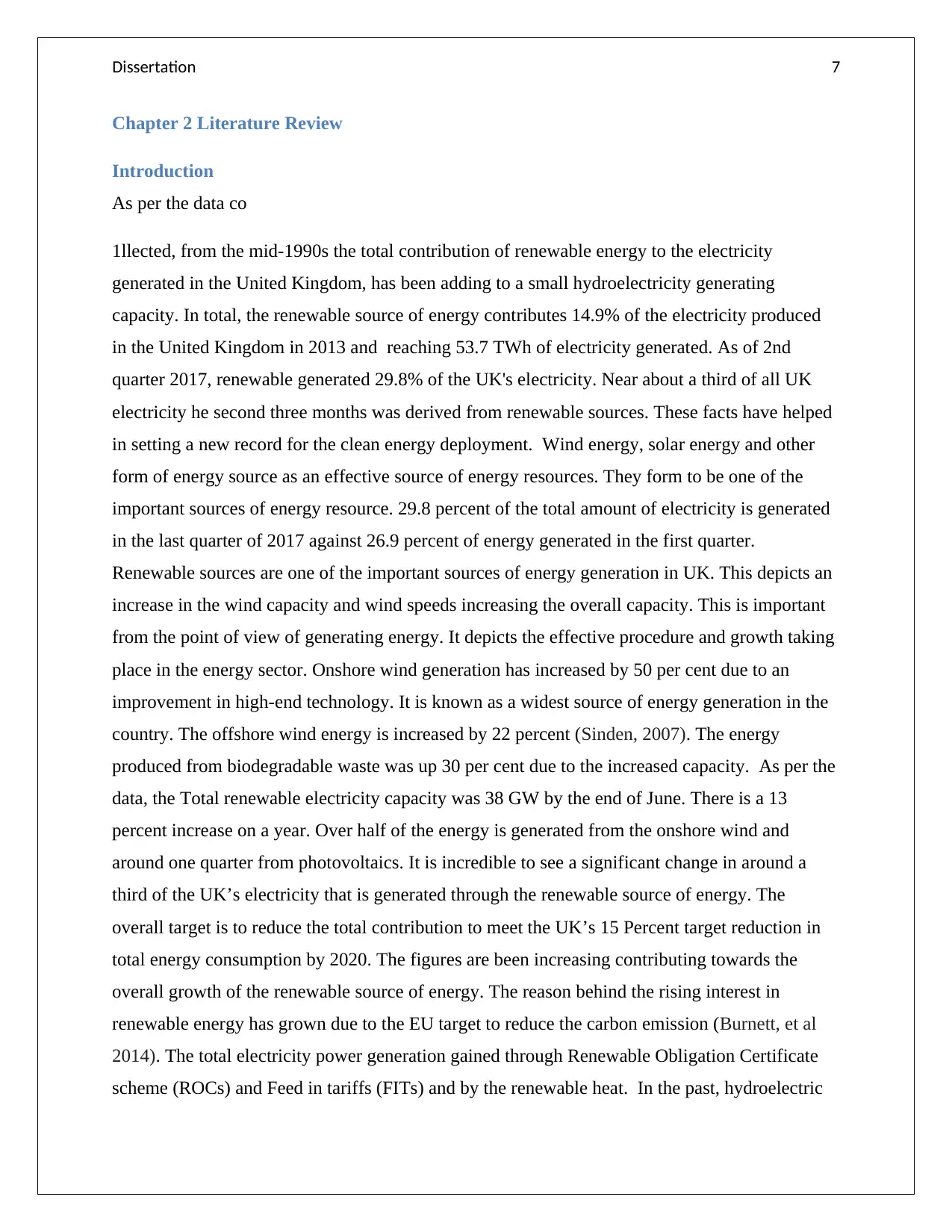
Dissertation 7
Chapter 2 Literature Review
Introduction
As per the data co
1llected, from the mid-1990s the total contribution of renewable energy to the electricity
generated in the United Kingdom, has been adding to a small hydroelectricity generating
capacity. In total, the renewable source of energy contributes 14.9% of the electricity produced
in the United Kingdom in 2013 and reaching 53.7 TWh of electricity generated. As of 2nd
quarter 2017, renewable generated 29.8% of the UK's electricity. Near about a third of all UK
electricity he second three months was derived from renewable sources. These facts have helped
in setting a new record for the clean energy deployment. Wind energy, solar energy and other
form of energy source as an effective source of energy resources. They form to be one of the
important sources of energy resource. 29.8 percent of the total amount of electricity is generated
in the last quarter of 2017 against 26.9 percent of energy generated in the first quarter.
Renewable sources are one of the important sources of energy generation in UK. This depicts an
increase in the wind capacity and wind speeds increasing the overall capacity. This is important
from the point of view of generating energy. It depicts the effective procedure and growth taking
place in the energy sector. Onshore wind generation has increased by 50 per cent due to an
improvement in high-end technology. It is known as a widest source of energy generation in the
country. The offshore wind energy is increased by 22 percent (Sinden, 2007). The energy
produced from biodegradable waste was up 30 per cent due to the increased capacity. As per the
data, the Total renewable electricity capacity was 38 GW by the end of June. There is a 13
percent increase on a year. Over half of the energy is generated from the onshore wind and
around one quarter from photovoltaics. It is incredible to see a significant change in around a
third of the UK’s electricity that is generated through the renewable source of energy. The
overall target is to reduce the total contribution to meet the UK’s 15 Percent target reduction in
total energy consumption by 2020. The figures are been increasing contributing towards the
overall growth of the renewable source of energy. The reason behind the rising interest in
renewable energy has grown due to the EU target to reduce the carbon emission (Burnett, et al
2014). The total electricity power generation gained through Renewable Obligation Certificate
scheme (ROCs) and Feed in tariffs (FITs) and by the renewable heat. In the past, hydroelectric
Chapter 2 Literature Review
Introduction
As per the data co
1llected, from the mid-1990s the total contribution of renewable energy to the electricity
generated in the United Kingdom, has been adding to a small hydroelectricity generating
capacity. In total, the renewable source of energy contributes 14.9% of the electricity produced
in the United Kingdom in 2013 and reaching 53.7 TWh of electricity generated. As of 2nd
quarter 2017, renewable generated 29.8% of the UK's electricity. Near about a third of all UK
electricity he second three months was derived from renewable sources. These facts have helped
in setting a new record for the clean energy deployment. Wind energy, solar energy and other
form of energy source as an effective source of energy resources. They form to be one of the
important sources of energy resource. 29.8 percent of the total amount of electricity is generated
in the last quarter of 2017 against 26.9 percent of energy generated in the first quarter.
Renewable sources are one of the important sources of energy generation in UK. This depicts an
increase in the wind capacity and wind speeds increasing the overall capacity. This is important
from the point of view of generating energy. It depicts the effective procedure and growth taking
place in the energy sector. Onshore wind generation has increased by 50 per cent due to an
improvement in high-end technology. It is known as a widest source of energy generation in the
country. The offshore wind energy is increased by 22 percent (Sinden, 2007). The energy
produced from biodegradable waste was up 30 per cent due to the increased capacity. As per the
data, the Total renewable electricity capacity was 38 GW by the end of June. There is a 13
percent increase on a year. Over half of the energy is generated from the onshore wind and
around one quarter from photovoltaics. It is incredible to see a significant change in around a
third of the UK’s electricity that is generated through the renewable source of energy. The
overall target is to reduce the total contribution to meet the UK’s 15 Percent target reduction in
total energy consumption by 2020. The figures are been increasing contributing towards the
overall growth of the renewable source of energy. The reason behind the rising interest in
renewable energy has grown due to the EU target to reduce the carbon emission (Burnett, et al
2014). The total electricity power generation gained through Renewable Obligation Certificate
scheme (ROCs) and Feed in tariffs (FITs) and by the renewable heat. In the past, hydroelectric
Paraphrase This Document
Need a fresh take? Get an instant paraphrase of this document with our AI Paraphraser
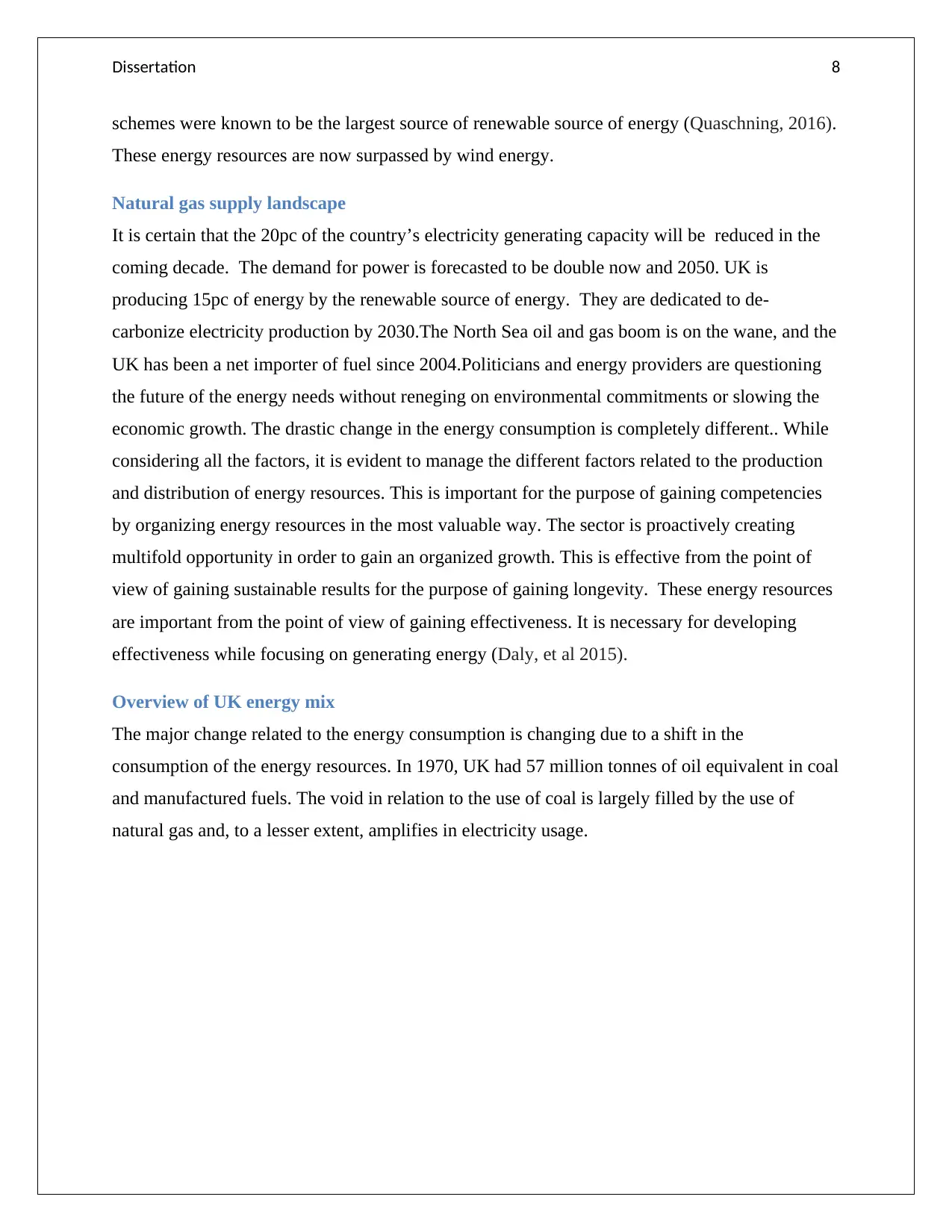
Dissertation 8
schemes were known to be the largest source of renewable source of energy (Quaschning, 2016).
These energy resources are now surpassed by wind energy.
Natural gas supply landscape
It is certain that the 20pc of the country’s electricity generating capacity will be reduced in the
coming decade. The demand for power is forecasted to be double now and 2050. UK is
producing 15pc of energy by the renewable source of energy. They are dedicated to de-
carbonize electricity production by 2030.The North Sea oil and gas boom is on the wane, and the
UK has been a net importer of fuel since 2004.Politicians and energy providers are questioning
the future of the energy needs without reneging on environmental commitments or slowing the
economic growth. The drastic change in the energy consumption is completely different.. While
considering all the factors, it is evident to manage the different factors related to the production
and distribution of energy resources. This is important for the purpose of gaining competencies
by organizing energy resources in the most valuable way. The sector is proactively creating
multifold opportunity in order to gain an organized growth. This is effective from the point of
view of gaining sustainable results for the purpose of gaining longevity. These energy resources
are important from the point of view of gaining effectiveness. It is necessary for developing
effectiveness while focusing on generating energy (Daly, et al 2015).
Overview of UK energy mix
The major change related to the energy consumption is changing due to a shift in the
consumption of the energy resources. In 1970, UK had 57 million tonnes of oil equivalent in coal
and manufactured fuels. The void in relation to the use of coal is largely filled by the use of
natural gas and, to a lesser extent, amplifies in electricity usage.
schemes were known to be the largest source of renewable source of energy (Quaschning, 2016).
These energy resources are now surpassed by wind energy.
Natural gas supply landscape
It is certain that the 20pc of the country’s electricity generating capacity will be reduced in the
coming decade. The demand for power is forecasted to be double now and 2050. UK is
producing 15pc of energy by the renewable source of energy. They are dedicated to de-
carbonize electricity production by 2030.The North Sea oil and gas boom is on the wane, and the
UK has been a net importer of fuel since 2004.Politicians and energy providers are questioning
the future of the energy needs without reneging on environmental commitments or slowing the
economic growth. The drastic change in the energy consumption is completely different.. While
considering all the factors, it is evident to manage the different factors related to the production
and distribution of energy resources. This is important for the purpose of gaining competencies
by organizing energy resources in the most valuable way. The sector is proactively creating
multifold opportunity in order to gain an organized growth. This is effective from the point of
view of gaining sustainable results for the purpose of gaining longevity. These energy resources
are important from the point of view of gaining effectiveness. It is necessary for developing
effectiveness while focusing on generating energy (Daly, et al 2015).
Overview of UK energy mix
The major change related to the energy consumption is changing due to a shift in the
consumption of the energy resources. In 1970, UK had 57 million tonnes of oil equivalent in coal
and manufactured fuels. The void in relation to the use of coal is largely filled by the use of
natural gas and, to a lesser extent, amplifies in electricity usage.
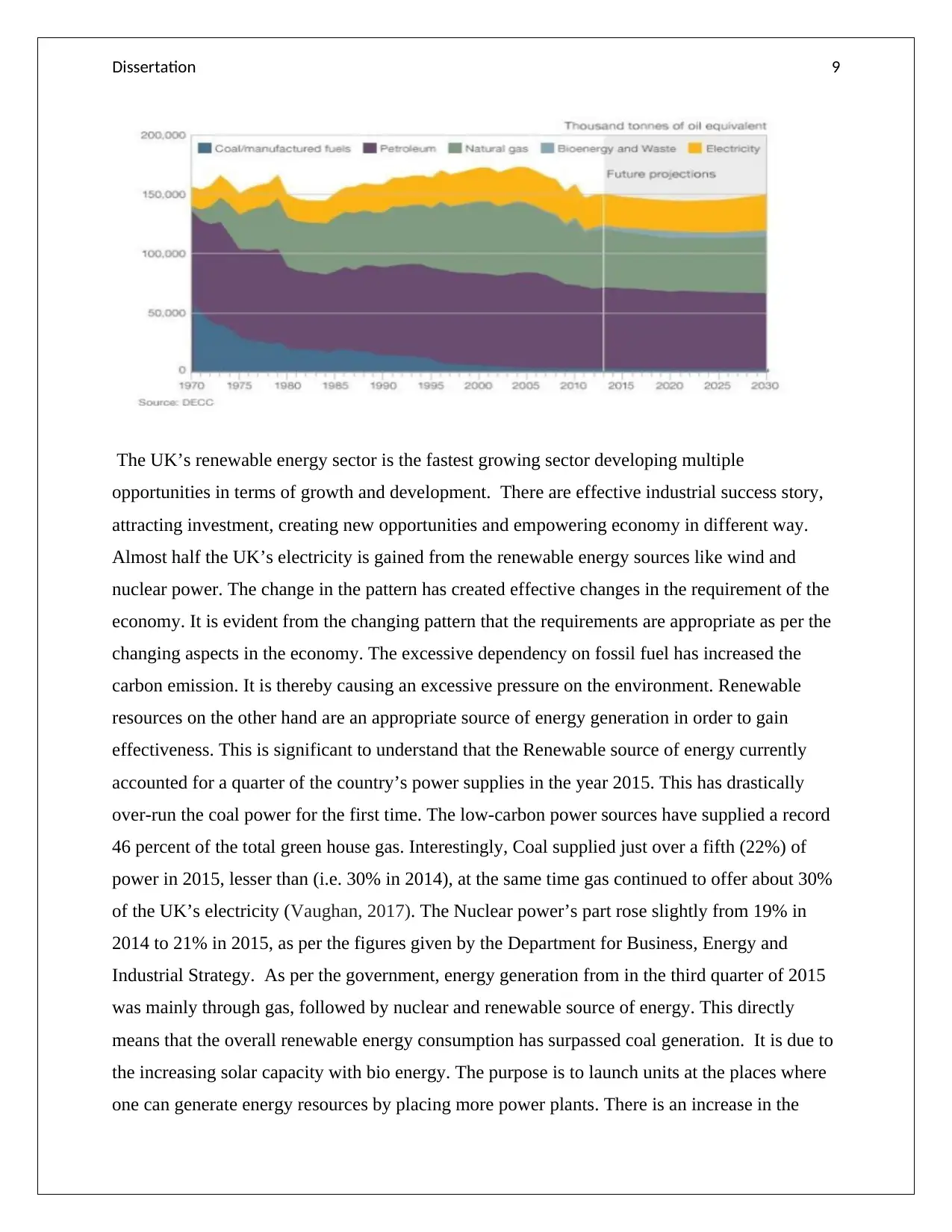
Dissertation 9
The UK’s renewable energy sector is the fastest growing sector developing multiple
opportunities in terms of growth and development. There are effective industrial success story,
attracting investment, creating new opportunities and empowering economy in different way.
Almost half the UK’s electricity is gained from the renewable energy sources like wind and
nuclear power. The change in the pattern has created effective changes in the requirement of the
economy. It is evident from the changing pattern that the requirements are appropriate as per the
changing aspects in the economy. The excessive dependency on fossil fuel has increased the
carbon emission. It is thereby causing an excessive pressure on the environment. Renewable
resources on the other hand are an appropriate source of energy generation in order to gain
effectiveness. This is significant to understand that the Renewable source of energy currently
accounted for a quarter of the country’s power supplies in the year 2015. This has drastically
over-run the coal power for the first time. The low-carbon power sources have supplied a record
46 percent of the total green house gas. Interestingly, Coal supplied just over a fifth (22%) of
power in 2015, lesser than (i.e. 30% in 2014), at the same time gas continued to offer about 30%
of the UK’s electricity (Vaughan, 2017). The Nuclear power’s part rose slightly from 19% in
2014 to 21% in 2015, as per the figures given by the Department for Business, Energy and
Industrial Strategy. As per the government, energy generation from in the third quarter of 2015
was mainly through gas, followed by nuclear and renewable source of energy. This directly
means that the overall renewable energy consumption has surpassed coal generation. It is due to
the increasing solar capacity with bio energy. The purpose is to launch units at the places where
one can generate energy resources by placing more power plants. There is an increase in the
The UK’s renewable energy sector is the fastest growing sector developing multiple
opportunities in terms of growth and development. There are effective industrial success story,
attracting investment, creating new opportunities and empowering economy in different way.
Almost half the UK’s electricity is gained from the renewable energy sources like wind and
nuclear power. The change in the pattern has created effective changes in the requirement of the
economy. It is evident from the changing pattern that the requirements are appropriate as per the
changing aspects in the economy. The excessive dependency on fossil fuel has increased the
carbon emission. It is thereby causing an excessive pressure on the environment. Renewable
resources on the other hand are an appropriate source of energy generation in order to gain
effectiveness. This is significant to understand that the Renewable source of energy currently
accounted for a quarter of the country’s power supplies in the year 2015. This has drastically
over-run the coal power for the first time. The low-carbon power sources have supplied a record
46 percent of the total green house gas. Interestingly, Coal supplied just over a fifth (22%) of
power in 2015, lesser than (i.e. 30% in 2014), at the same time gas continued to offer about 30%
of the UK’s electricity (Vaughan, 2017). The Nuclear power’s part rose slightly from 19% in
2014 to 21% in 2015, as per the figures given by the Department for Business, Energy and
Industrial Strategy. As per the government, energy generation from in the third quarter of 2015
was mainly through gas, followed by nuclear and renewable source of energy. This directly
means that the overall renewable energy consumption has surpassed coal generation. It is due to
the increasing solar capacity with bio energy. The purpose is to launch units at the places where
one can generate energy resources by placing more power plants. There is an increase in the
⊘ This is a preview!⊘
Do you want full access?
Subscribe today to unlock all pages.

Trusted by 1+ million students worldwide
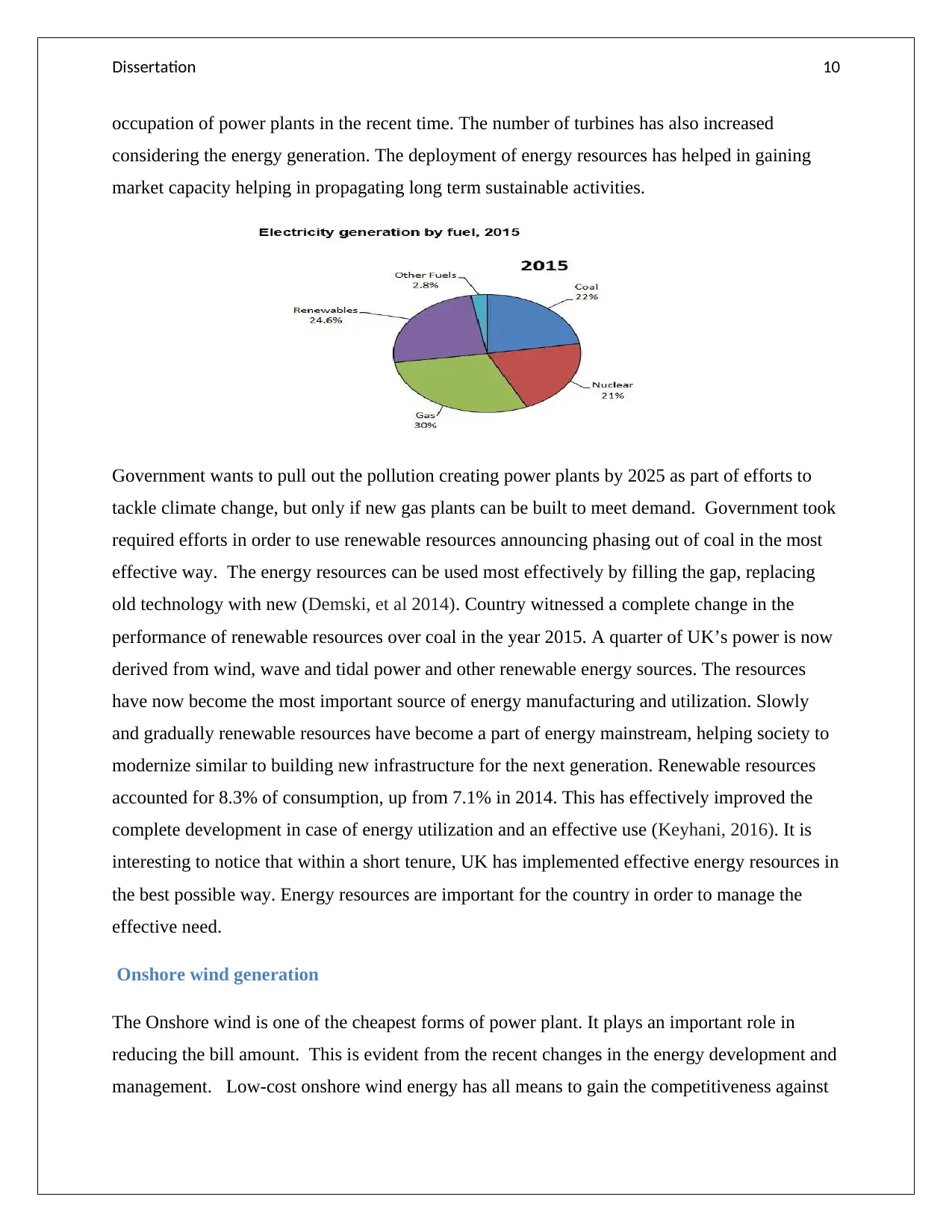
Dissertation 10
occupation of power plants in the recent time. The number of turbines has also increased
considering the energy generation. The deployment of energy resources has helped in gaining
market capacity helping in propagating long term sustainable activities.
Government wants to pull out the pollution creating power plants by 2025 as part of efforts to
tackle climate change, but only if new gas plants can be built to meet demand. Government took
required efforts in order to use renewable resources announcing phasing out of coal in the most
effective way. The energy resources can be used most effectively by filling the gap, replacing
old technology with new (Demski, et al 2014). Country witnessed a complete change in the
performance of renewable resources over coal in the year 2015. A quarter of UK’s power is now
derived from wind, wave and tidal power and other renewable energy sources. The resources
have now become the most important source of energy manufacturing and utilization. Slowly
and gradually renewable resources have become a part of energy mainstream, helping society to
modernize similar to building new infrastructure for the next generation. Renewable resources
accounted for 8.3% of consumption, up from 7.1% in 2014. This has effectively improved the
complete development in case of energy utilization and an effective use (Keyhani, 2016). It is
interesting to notice that within a short tenure, UK has implemented effective energy resources in
the best possible way. Energy resources are important for the country in order to manage the
effective need.
Onshore wind generation
The Onshore wind is one of the cheapest forms of power plant. It plays an important role in
reducing the bill amount. This is evident from the recent changes in the energy development and
management. Low-cost onshore wind energy has all means to gain the competitiveness against
occupation of power plants in the recent time. The number of turbines has also increased
considering the energy generation. The deployment of energy resources has helped in gaining
market capacity helping in propagating long term sustainable activities.
Government wants to pull out the pollution creating power plants by 2025 as part of efforts to
tackle climate change, but only if new gas plants can be built to meet demand. Government took
required efforts in order to use renewable resources announcing phasing out of coal in the most
effective way. The energy resources can be used most effectively by filling the gap, replacing
old technology with new (Demski, et al 2014). Country witnessed a complete change in the
performance of renewable resources over coal in the year 2015. A quarter of UK’s power is now
derived from wind, wave and tidal power and other renewable energy sources. The resources
have now become the most important source of energy manufacturing and utilization. Slowly
and gradually renewable resources have become a part of energy mainstream, helping society to
modernize similar to building new infrastructure for the next generation. Renewable resources
accounted for 8.3% of consumption, up from 7.1% in 2014. This has effectively improved the
complete development in case of energy utilization and an effective use (Keyhani, 2016). It is
interesting to notice that within a short tenure, UK has implemented effective energy resources in
the best possible way. Energy resources are important for the country in order to manage the
effective need.
Onshore wind generation
The Onshore wind is one of the cheapest forms of power plant. It plays an important role in
reducing the bill amount. This is evident from the recent changes in the energy development and
management. Low-cost onshore wind energy has all means to gain the competitiveness against
Paraphrase This Document
Need a fresh take? Get an instant paraphrase of this document with our AI Paraphraser

Dissertation 11
the other source of energy generation. In the recent time there is an increase by 50 per cent as
compared to the same period last year (Moseley and Garche, 2014). The increasing dependency
on the onshore wind energy has helped in developing an effective status. It has helped in
managing key effectiveness in order to gain effectiveness in terms of long-term energy
generation. The primary goal is to attain effectiveness in order to reduce the dependency on the
other source of energy generation (Devine-Wright, 2014). There is a consistent strong support
from people in UK regarding the use of wind power. Around three quarters of the population has
agreed upon using onshore turbine. In 2015, 40.4 TWh of energy was generated by wind power
(Markides, 2013). Three large offshore plant came into operation in the year 2015 are: Gwynt y
Môr (576 MW max. capacities), Humber Gateway (219 MW) and Westermost Rough (210
MW). Biofuels utilization has expanded on normal by 0.47% in the vicinity of 2009 and 2015,
demonstrating an enormous log jam in this last year (- 19.7% utilization in 2015 contrasted with
the volume in 2014(Wheeler and Hunt, 2016). Occupations and market esteem keep on develop
yet at a slower pace than trusted and unevenly over the divisions Proceeded with solid
sustainable power source development debilitated by strategy changes. From information gave
by Innovas, 117,000 individuals were utilized over the UK sustainable power source esteem
chain in2014/15, an expansion of 4.2% on the earlier year. The quantity of organizations
working in the segment has diminished, from a little more than 6810 to less than 6790, a
difference in - 0.4%. The segment with the biggest number of organizations taking an interest in
it remains sun oriented PV with more than 2000. Be that as it may, this segment saw the biggest
decrease of associations from 2013/14 to 2014/15, contracting by 4%, with advance decreases
foreseen through 2016 as later changes to Nourish in Levy strategy unfavourably affect work
prospects in the division. The businesses fairly estimated worth has expanded over that time by
6.8% to £15.91bn.
Renewable energy provision in the UK
It is Through the Renewable Obligation, the British electricity suppliers have to supply the
electricity into a proportion of their sales from renewable sources such as wind power. Non-
compliance of this will lead to penalty (Inglesi-Lotz, 2016). The supplier get a Renewable
Obligation Certificate (ROC) for each MW·h of electricity. Wind energy is one of the largest
sources of renewable electricity. There are certain pre-notions that the wind energy has increased
the overall cost (Ellabban, Abu-Rub and Blaabjerg, 2014).
the other source of energy generation. In the recent time there is an increase by 50 per cent as
compared to the same period last year (Moseley and Garche, 2014). The increasing dependency
on the onshore wind energy has helped in developing an effective status. It has helped in
managing key effectiveness in order to gain effectiveness in terms of long-term energy
generation. The primary goal is to attain effectiveness in order to reduce the dependency on the
other source of energy generation (Devine-Wright, 2014). There is a consistent strong support
from people in UK regarding the use of wind power. Around three quarters of the population has
agreed upon using onshore turbine. In 2015, 40.4 TWh of energy was generated by wind power
(Markides, 2013). Three large offshore plant came into operation in the year 2015 are: Gwynt y
Môr (576 MW max. capacities), Humber Gateway (219 MW) and Westermost Rough (210
MW). Biofuels utilization has expanded on normal by 0.47% in the vicinity of 2009 and 2015,
demonstrating an enormous log jam in this last year (- 19.7% utilization in 2015 contrasted with
the volume in 2014(Wheeler and Hunt, 2016). Occupations and market esteem keep on develop
yet at a slower pace than trusted and unevenly over the divisions Proceeded with solid
sustainable power source development debilitated by strategy changes. From information gave
by Innovas, 117,000 individuals were utilized over the UK sustainable power source esteem
chain in2014/15, an expansion of 4.2% on the earlier year. The quantity of organizations
working in the segment has diminished, from a little more than 6810 to less than 6790, a
difference in - 0.4%. The segment with the biggest number of organizations taking an interest in
it remains sun oriented PV with more than 2000. Be that as it may, this segment saw the biggest
decrease of associations from 2013/14 to 2014/15, contracting by 4%, with advance decreases
foreseen through 2016 as later changes to Nourish in Levy strategy unfavourably affect work
prospects in the division. The businesses fairly estimated worth has expanded over that time by
6.8% to £15.91bn.
Renewable energy provision in the UK
It is Through the Renewable Obligation, the British electricity suppliers have to supply the
electricity into a proportion of their sales from renewable sources such as wind power. Non-
compliance of this will lead to penalty (Inglesi-Lotz, 2016). The supplier get a Renewable
Obligation Certificate (ROC) for each MW·h of electricity. Wind energy is one of the largest
sources of renewable electricity. There are certain pre-notions that the wind energy has increased
the overall cost (Ellabban, Abu-Rub and Blaabjerg, 2014).
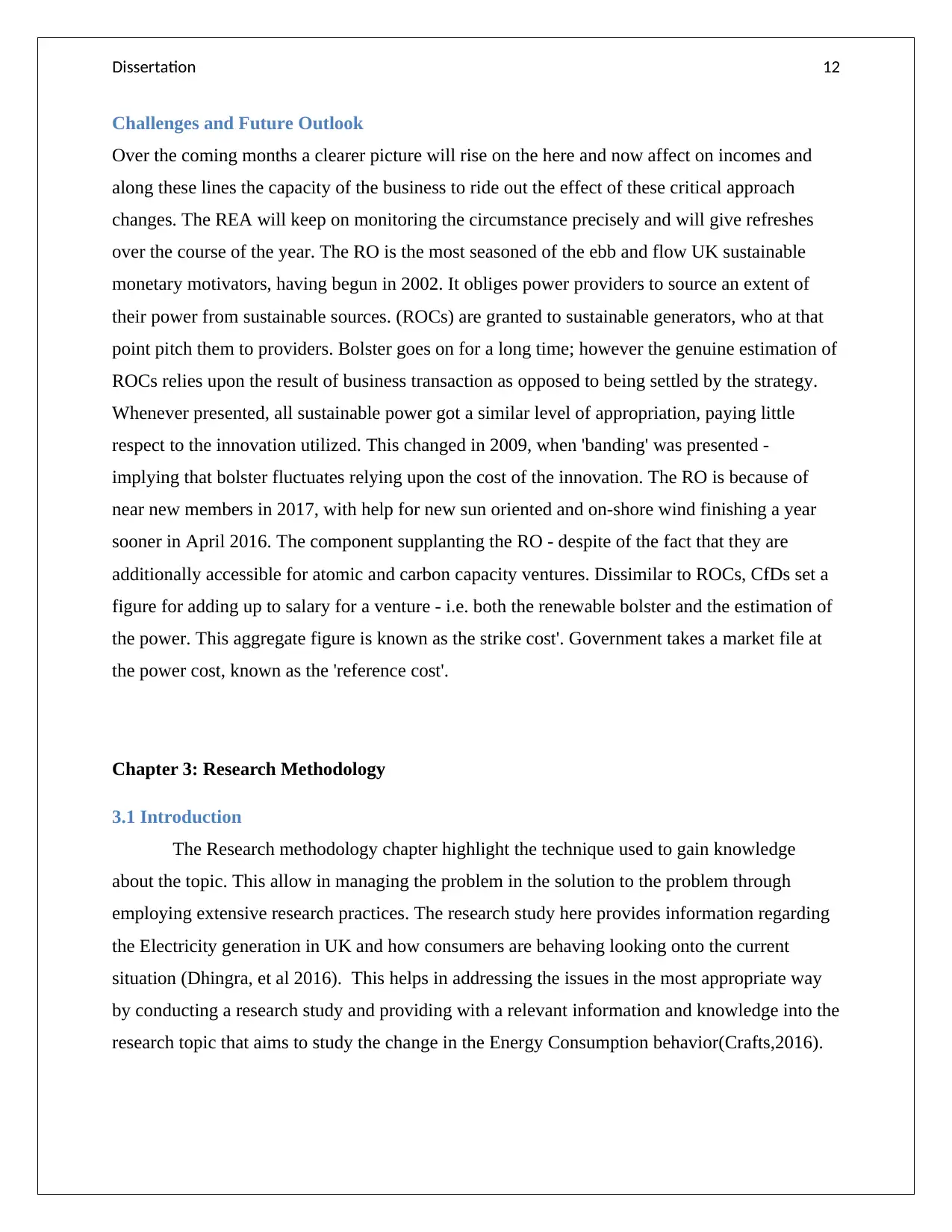
Dissertation 12
Challenges and Future Outlook
Over the coming months a clearer picture will rise on the here and now affect on incomes and
along these lines the capacity of the business to ride out the effect of these critical approach
changes. The REA will keep on monitoring the circumstance precisely and will give refreshes
over the course of the year. The RO is the most seasoned of the ebb and flow UK sustainable
monetary motivators, having begun in 2002. It obliges power providers to source an extent of
their power from sustainable sources. (ROCs) are granted to sustainable generators, who at that
point pitch them to providers. Bolster goes on for a long time; however the genuine estimation of
ROCs relies upon the result of business transaction as opposed to being settled by the strategy.
Whenever presented, all sustainable power got a similar level of appropriation, paying little
respect to the innovation utilized. This changed in 2009, when 'banding' was presented -
implying that bolster fluctuates relying upon the cost of the innovation. The RO is because of
near new members in 2017, with help for new sun oriented and on-shore wind finishing a year
sooner in April 2016. The component supplanting the RO - despite of the fact that they are
additionally accessible for atomic and carbon capacity ventures. Dissimilar to ROCs, CfDs set a
figure for adding up to salary for a venture - i.e. both the renewable bolster and the estimation of
the power. This aggregate figure is known as the strike cost'. Government takes a market file at
the power cost, known as the 'reference cost'.
Chapter 3: Research Methodology
3.1 Introduction
The Research methodology chapter highlight the technique used to gain knowledge
about the topic. This allow in managing the problem in the solution to the problem through
employing extensive research practices. The research study here provides information regarding
the Electricity generation in UK and how consumers are behaving looking onto the current
situation (Dhingra, et al 2016). This helps in addressing the issues in the most appropriate way
by conducting a research study and providing with a relevant information and knowledge into the
research topic that aims to study the change in the Energy Consumption behavior(Crafts,2016).
Challenges and Future Outlook
Over the coming months a clearer picture will rise on the here and now affect on incomes and
along these lines the capacity of the business to ride out the effect of these critical approach
changes. The REA will keep on monitoring the circumstance precisely and will give refreshes
over the course of the year. The RO is the most seasoned of the ebb and flow UK sustainable
monetary motivators, having begun in 2002. It obliges power providers to source an extent of
their power from sustainable sources. (ROCs) are granted to sustainable generators, who at that
point pitch them to providers. Bolster goes on for a long time; however the genuine estimation of
ROCs relies upon the result of business transaction as opposed to being settled by the strategy.
Whenever presented, all sustainable power got a similar level of appropriation, paying little
respect to the innovation utilized. This changed in 2009, when 'banding' was presented -
implying that bolster fluctuates relying upon the cost of the innovation. The RO is because of
near new members in 2017, with help for new sun oriented and on-shore wind finishing a year
sooner in April 2016. The component supplanting the RO - despite of the fact that they are
additionally accessible for atomic and carbon capacity ventures. Dissimilar to ROCs, CfDs set a
figure for adding up to salary for a venture - i.e. both the renewable bolster and the estimation of
the power. This aggregate figure is known as the strike cost'. Government takes a market file at
the power cost, known as the 'reference cost'.
Chapter 3: Research Methodology
3.1 Introduction
The Research methodology chapter highlight the technique used to gain knowledge
about the topic. This allow in managing the problem in the solution to the problem through
employing extensive research practices. The research study here provides information regarding
the Electricity generation in UK and how consumers are behaving looking onto the current
situation (Dhingra, et al 2016). This helps in addressing the issues in the most appropriate way
by conducting a research study and providing with a relevant information and knowledge into the
research topic that aims to study the change in the Energy Consumption behavior(Crafts,2016).
⊘ This is a preview!⊘
Do you want full access?
Subscribe today to unlock all pages.

Trusted by 1+ million students worldwide
1 out of 37
Related Documents
Your All-in-One AI-Powered Toolkit for Academic Success.
+13062052269
info@desklib.com
Available 24*7 on WhatsApp / Email
![[object Object]](/_next/static/media/star-bottom.7253800d.svg)
Unlock your academic potential
Copyright © 2020–2025 A2Z Services. All Rights Reserved. Developed and managed by ZUCOL.

![Energy Security: Regional Dimensions Essay - [University Name]](/_next/image/?url=https%3A%2F%2Fdesklib.com%2Fmedia%2Fimages%2Fda%2F83117328299f4e9da5664a7fcb7634cb.jpg&w=256&q=75)



